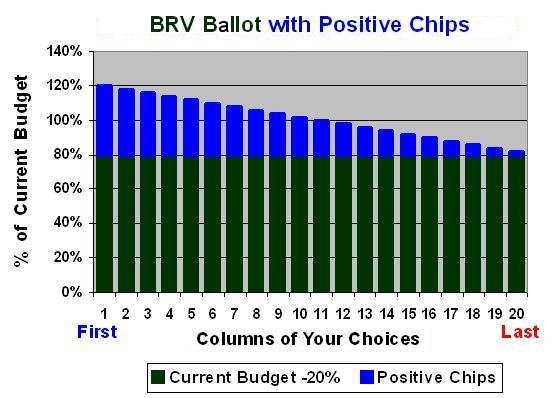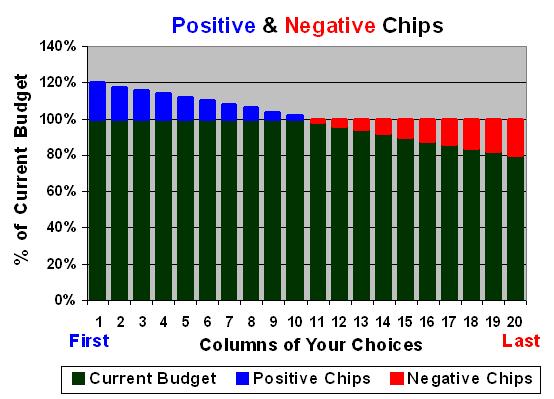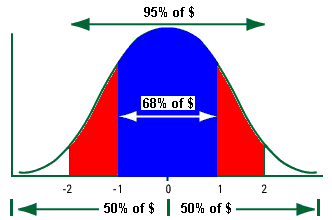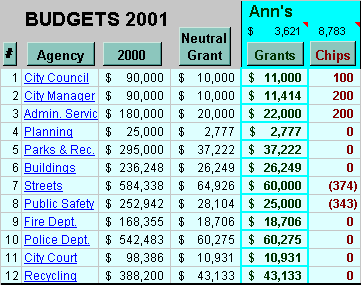|
Different uses for voting
need different types of voting. |
 |
Budget-Setting Votes |
 |

|
|
Basic Budget ProcessThe Voting Workshop taught a simple way to vote for budgets. That manual tally board works well for groups with 10 to 50 voters and less than 30 departments. Voters can then use the same process to allocate a department's grants among its bureaus. This page builds on the workshop's budget-setting rule and shows how larger groups can use it.
Recall that in a manual vote for projects, each voter in turn gave one card to a favorite item, starting with the biggest card for his favorite department. When a computer aids the tally, each voter gets many cards. These cards change in value only a little from one to the next. The tally automatically gives your largest cards to your favorite. Even with computer voting, reps have to “put their cards on the table” for everyone to see. Their tally table is a bar chart like the one below, with columns for each department. A big department has many columns. A voter is allowed to put only one card in each column. A voter still places cards to cause budget changes; and then moves them to counter budget changes by other voters. The bar chart below shows a voter's ballot adding cards to agency budgets. The first column of his favorite agency is the first column on the left. It gets his biggest blue card. The agency at the middle gets a neutral grant, a vote that makes no change from the current budget. |

|
A big department has several columns.
Can Ballots Respond?Like Movable Money Votes for One Time Resource Allocations, BRV can fit budget items along a voter's utility curve automatically. But BRV does not eliminate items. Simple BallotVoters mark only target budgets. The item with the lowest percentage of your target gets the highest Priority Estimate. So it gets first place on your utility curve. It gets the most money you're allowed to give it. This is easy for the voter, but it does not let him explicitly choose which item gets his highest priority. Better Ballot (more control in voter's hands)A voter marks his target budgets and his priorities. He marks his priorities with preference ranks, grades or scores — the same kind of preference ballots used to elect candidates, enact policies, or select projects. The item with your highest priority gets first place on your utility curve. It gets the most money you're allowed to give it. But if an item's tally budget goes over your target for it, then it's priority drops to zero on your ballot. It drops to last place on your utility curve. That means it gets none of your money. Other items move up your utility curve; so they get more of your money. Tie breakerWhen a voter grades several items as tied for his next card, which of them gets it? The item with a lower percentage of his target gets a higher Priority Estimate.Automated TallyWhile BRV Automated does not eliminate items, the program does transfer money from items over the voter's target to his favorite under-funded item. 1) Each voter's ballot in its turn puts the current voting card in an open column of its favorite under-funded item. It does not give to a favorite (high-priority vote) item that has reached his target. The process lets your ballot help fund an item up to your target. But two voters with the same target will pay different amounts if their priorities are different. The voter who says it is a high priority will give the item much more than the voter who says it is a low priority. That is fair and logical. 2) When it's your ballot's turn to give a card, it might find one or more favorites have gone over your targets for them. Your ballot can move one card from one item to your favorite item that has not reached its target. It moves the biggest card that will not send a favorite below its target. Then it puts the current card in the next open column. Eventually all voting cards are placed in columns. Ballots continue taking turns as in step 2 above. It's crude to turn off funding suddenly when an item reaches its target. If my first were near its target and my second were far from target, then I would probably give the second more of my money, if this were a hands-on tally. Its distance from my target could become an item's multiplier for a Priority Estimate. But many voters would want to fill their top priority before funding the next lower priority. It would take a great deal of information and effort from a voter to tell us the "marginal utility" of adding a dollar to item K versus adding a dollar to item L at every level of funding. Most voters would dislike such a difficult ballot. That is why basic BRV is not automated. But it needs each voter to pay attention and respond. The next method lets you respond to budget changes by other voters by changing your budgets as in basic BRV or perhaps by changing your grades for several automated steps.
Repeated PollingAn organization with substantial budgets may need to evaluate the budgets repeatedly as they develope. Budget Refill Voting r (BRVr) does not require immediate voter interaction to cause and counter budget changes. Instead, it alternates discussions with a series of separate surveys, each one allocating less money than the previous survey as voters fine tune the budgets. Take a survey with budgets starting 20% below their current levels.
(There is another way to decrease the power of each round. The first round of voting uses the steepest utility curve; the last round uses a much flatter line or curve.) This method of BRV does not need to have every member online at the same time. It allows peaceful time for discussion. But the voting and tallies can be done quickly. Many organizations set their budgets at an annual meeting held over a long weekend. Members can cast their ballots as they enter the dining room and no later than the start of the [lunch or dinner] speaker. They can get the results and the next ballot as they leave.
Negative Card VotingNegative cards used in Hylland and Zeckhauser's original rule (H-Z) make the process much more adversarial. That may be good for public legislatures but probably is not good for voluntary groups such as clubs, colleges, coops, condos, or congregations. H-Z is more honest, but brutal honesty may hurt relationships. Negative cards also let a majority counter every vote by all other groups, thus denying them power.Negative votes can have a negative effect even if the ballots are secret: When we decide to hurt someone, we tend to like them less in order to justify having hurt them. On a tally board, the new budget is half way between the lowest negative card in the column and the highest positive card. This makes it harder for voters to read the current budget than positive cards alone. |

|
A big department has several columns.
Notes on Four VariationsSeveral rules can give fair shares of power to all voters setting budgets — just as there are several used for fair-share representation, and several to meet Condorcet's criterion. Each power-sharing rule for budgets meets basic goals for fairness and efficiency in different ways. But their differences are small compared to the change from winner-take-all to fair shares. The rules on this page differ mainly in the ways they get voters to spread out their money. BRV rules use hard limits or soft incentives to set minimum and maximum grants. The next page will present five budget rules with unrelated methods. You can find software for each of these voting rules on the tools page. They are free to download or to use online. Budget Priorities1a) Sets of cards: The first method is described above. Each voter gets a set of cards that cover a range of size or value. These force the voter to smoothly spread his grants. This spread is chosen by the whoever made the set of cards. Economists call this distribution a “utility curve. ” Merits: It can be demonstrated on a tally board. It can use simple ballots with ranks or grades tallied by computer. This rule is the easiest for voters. It requires less time than other rules. There are few numbers to juggle or strategies to be troubled about.
1b) Personal scores: Giving a personal score to each item can place the items in order. This is just like the scored ballot for selecting projects.
[ 1c) Normal bell-curve: The utility curve could normalize the scores on a voter's ballot. The voter has some freedom to vary the gaps between adjacent favorites. But her overall distribution is adjusted so its average is 0 (no change). Its extremes are limited to about +3 and -3; and very little funding can reach those extremes. In fact, the more funding she moves toward the upper and lower limits, the more those limits move toward zero.
 You might see a similarity in this divider:
2) BRV Budget Limits: These let a voter grant a department as little or as much as he wants up to a maximum. That maximum might be 150% of the agency's neutral grant.
3) BRV Budget Grant-Tax: A voter pays no tax to grant a department his share of its current budget. The more he tries to change that "neutral grant" the more tax he pays. This is a progressive influence tax. Influence on a budget means the percentage change from a neutral vote, that is a vote that makes no change. When a voter increases a budget, he pays some money to the tax; the bigger the change, the bigger his tax. His tax payment is divided among all other voters for the next round of voting.
4) Influence Points: This charges the voter who changes a budget by taking some of his political influence points, not by taking some of his money. (The charge is based on the square root of the percentage change in the budget, not the square root of the dollars or points.)
More advanced budget-setting rules, Voter Influence Points, and the Square Root Voting were invented before Budget Refill Voting. BRV came out of practical considerations and experience. It is much easier to explain and to program. It almost as effective at being fair while funding departments favored by many voters. |
|
|

|

|
|






 Accurate Democracy
Accurate Democracy 






